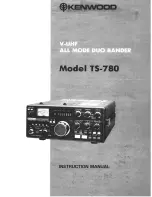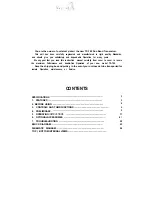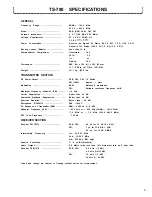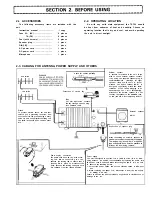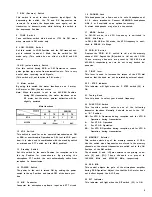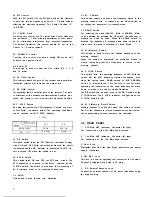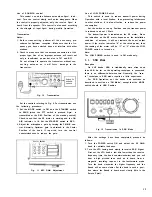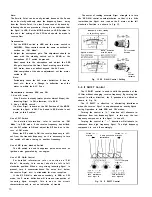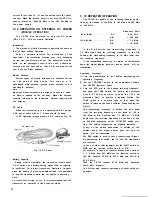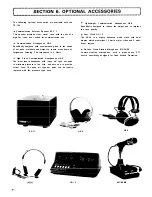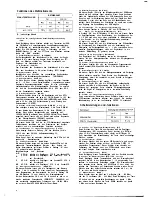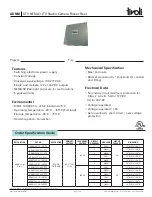
Note:
The Zero-in Point can be easily located because the Sound
loses its clarity suddenly when the frequency Passes
away
from the Zero-in Point. If a clear Sound cannot be heard by
following the above procedure, it may be an indication that
the Signal is LSB. Set the MODE switch to LSB Position. In
this case, the setting of the VFO knob should be made in
reverse Order.
Transmission
1. Set the MODE switch to USB and the meter switch to
ALC/CEN. Other controls remain the same as outlined in
section on “FM Mode”.
2. Adjust the microphone gain. This adjustment should be
made with the standby switch set to SEND or the
microphone PTT switch depressed.
Next, speak into the microphone and adjust the SSB
Mic gain control on the front Panel, making sure that the
ALC meter does not deflect beyond the ALC zone.
After completion of the above adjustment, set the meter
switch to RF.
Note:
Periodically check the ALC meter deflection. lf, due to
heat, etc., there
iS
a Change in deflection, reset the
meter to within the ALC Zone.
Discrimination between SSB and FM
1. Use of S meter
If the S meter is steady (meter pointer almost Stops), the
incoming Signal is FM; otherwise, it is SSB.
2. Use of MODE switch
If a clear Signal is heard at the FM Position of the MODE
switch, the Signal is FM. The Sound in SSB mode is not
heard at this Position.
Use of RIT Switch
F o r d e t a i l e d i n f o r m a t i o n , r e f e r t o s e c t i o n o n “ F M
Mode”. In SSB mode, if the receive frequency has drifted,
set the RIT switch to ON and adjust the RIT knob, as in the
case of FM mode.
When the RIT switch is ON, the receive frequency is off-
set from the transmit frequency, so it is necessary to turn
the switch off when tuning to another frequency.
Use of NB (noise blanker) Switch
The NB switch is used to suppress pulse noise such as
ignition noise generated by car engine.
Use of RF GAIN Control
F o r d e t a i l e d i n f o r m a t i o n , r e f e r t o s e c t i o n o n “ F M
M o d e ” .
N o r m a l l y , t h i s c o n t r o l s h o u l d b e l e f t i n f u l l
clockwise position. When a very strong incoming Signal is
present, turn it counterclockwise. The noise level below
the receive Signal level is attenuated for clear reception.
If the RF GAIN is reduced excessively in SSB or CW
mode, the S meter deflection will increase irrespective of
i n c o m i n g Signal s t r e n g t h . T h i s i s d u e t o t h e c i r c u i t
characteristics and is not an indication of trouble.
The secret of reading accurate Signal strength is to turn
the RF GAIN control counterclockwise so that it is a little
lower than the Signal level read on the S meter at the full
clockwise Position, as shown in Fig. 13.
Maximum S meter reading
of an incoming signal.
I
I
Meter deflection
clockwise
Signals weaker
with RF GAIN
Position
counter-
clockwise.
Fig. 13 RF GAIN Control Setting
5-4 IF SHIFT Control
The IF SHIFT control is used to shift the passband of the
IF filter without changing receive frequency. By turning this
control in either direction, the IF passband is shifted as
shown in Fig. 14.
The IF SHIFT is effective in eliminating interference
when the receive Signal is superimposed on nearby Signals
during Operation in both SSB and CW modes.
Turning the control in “+”
direction will eliminate in-
terference from low frequency Signal. In this way, the low
frequency component in the Signal is cut off.
Turning the control in ” - ” direction will eliminate in-
terference from high frequency Signal. The high frequency
component is cut off accordingly.
Turned in “- ”
Turned in ” + ”
direction
IF filter p a s s b a n d direction
characteristic
Signal
nate interference
n a t e tnterference
f r o m Signal B
f r o m Signal A
Fig. 14 IF SHIFT Control
13

